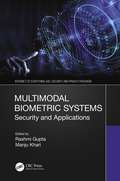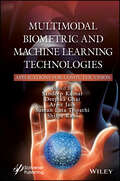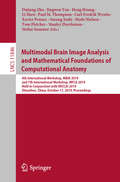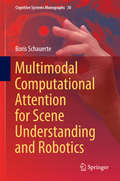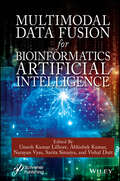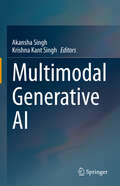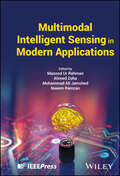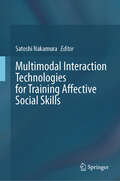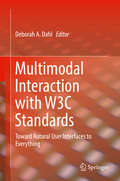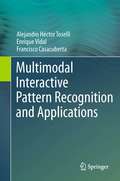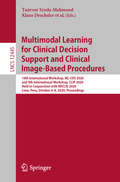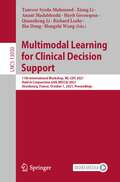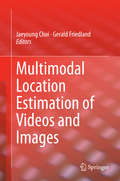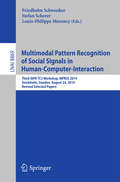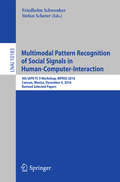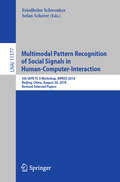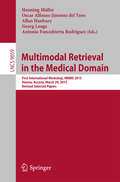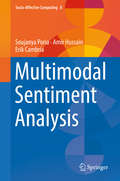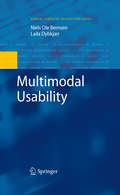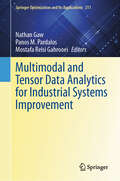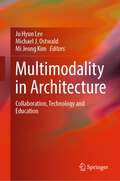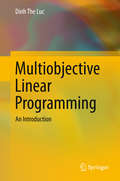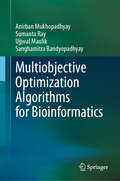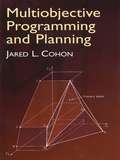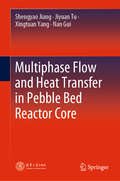- Table View
- List View
Multimodal Biometric Systems: Security and Applications (Internet of Everything (IoE))
by Prof. Dr. Rashmi Gupta Dr Manju KhariMany governments around the world are calling for the use of biometric systems to provide crucial societal functions, consequently making it an urgent area for action. The current performance of some biometric systems in terms of their error rates, robustness, and system security may prove to be inadequate for large-scale applications to process millions of users at a high rate of throughput. This book focuses on fusion in biometric systems. It discusses the present level, the limitations, and proposed methods to improve performance. It describes the fundamental concepts, current research, and security-related issues. The book will present a computational perspective, identify challenges, and cover new problem-solving strategies, offering solved problems and case studies to help with reader comprehension and deep understanding. This book is written for researchers, practitioners, both undergraduate and post-graduate students, and those working in various engineering fields such as Systems Engineering, Computer Science, Information Technology, Electronics, and Communications.
Multimodal Biometric and Machine Learning Technologies: Applications for Computer Vision
by Sandeep Kumar Suman Lata Tripathi Shilpa Rani Deepika Ghai Arpit JainMULTIMODAL BIOMETRIC AND MACHINE LEARNING TECHNOLOGIES With an increasing demand for biometric systems in various industries, this book on multimodal biometric systems, answers the call for increased resources to help researchers, developers, and practitioners. Multimodal biometric and machine learning technologies have revolutionized the field of security and authentication. These technologies utilize multiple sources of information, such as facial recognition, voice recognition, and fingerprint scanning, to verify an individual???s identity. The need for enhanced security and authentication has become increasingly important, and with the rise of digital technologies, cyber-attacks and identity theft have increased exponentially. Traditional authentication methods, such as passwords and PINs, have become less secure as hackers devise new ways to bypass them. In this context, multimodal biometric and machine learning technologies offer a more secure and reliable approach to authentication. This book provides relevant information on multimodal biometric and machine learning technologies and focuses on how humans and computers interact to ever-increasing levels of complexity and simplicity. The book provides content on the theory of multimodal biometric design, evaluation, and user diversity, and explains the underlying causes of the social and organizational problems that are typically devoted to descriptions of rehabilitation methods for specific processes. Furthermore, the book describes new algorithms for modeling accessible to scientists of all varieties. Audience Researchers in computer science and biometrics, developers who are designing and implementing biometric systems, and practitioners who are using biometric systems in their work, such as law enforcement personnel or healthcare professionals.
Multimodal Brain Image Analysis and Mathematical Foundations of Computational Anatomy: 4th International Workshop, MBIA 2019, and 7th International Workshop, MFCA 2019, Held in Conjunction with MICCAI 2019, Shenzhen, China, October 17, 2019, Proceedings (Lecture Notes in Computer Science #11846)
by Tom Fletcher Carl-Fredrik Westin Xavier Pennec Sarang Joshi Mads Nielsen Li Shen Stanley Durrleman Stefan Sommer Dajiang Zhu Jingwen Yan Heng Huang Paul M. ThompsonThis book constitutes the refereed joint proceedings of the 4th International Workshop on Multimodal Brain Image Analysis, MBAI 2019, and the 7th International Workshop on Mathematical Foundations of Computational Anatomy, MFCA 2019, held in conjunction with the 22nd International Conference on Medical Imaging and Computer-Assisted Intervention, MICCAI 2019, in Shenzhen, China, in October 2019. The 16 full papers presented at MBAI 2019 and the 7 full papers presented at MFCA 2019 were carefully reviewed and selected. The MBAI papers intend to move forward the state of the art in multimodal brain image analysis, in terms of analysis methodologies, algorithms, software systems, validation approaches, benchmark datasets, neuroscience, and clinical applications. The MFCA papers are devoted to statistical and geometrical methods for modeling the variability of biological shapes. The goal is to foster the interactions between the mathematical community around shapes and the MICCAI community around computational anatomy applications.
Multimodal Computational Attention for Scene Understanding and Robotics
by Boris SchauerteThis book presents state-of-the-art computationalattention models that have been successfully tested in diverse applicationareas and can build the foundation for artificial systems to efficientlyexplore, analyze, and understand natural scenes. It gives a comprehensive overview of the most recentcomputational attention models for processing visual and acoustic input. Itcovers the biological background of visual and auditory attention, as well as bottom-up and top-down attentionalmechanisms and discusses various applications. In the first part new approachesfor bottom-up visual and acoustic saliency models are presented and applied tothe task of audio-visual scene exploration of a robot. In the second part theinfluence of top-down cues for attention modeling is investigated.
Multimodal Data Fusion for Bioinformatics Artificial Intelligence
by Abhishek Kumar Vishal Dutt Narayan Vyas Umesh Kumar Lilhore Sarita SimaiyaMultimodal Data Fusion for Bioinformatics Artificial Intelligence is a must-have for anyone interested in the intersection of AI and bioinformatics, as it delves into innovative data fusion methods and their applications in ‘omics’ research while addressing the ethical implications and future developments shaping the field today. Multimodal Data Fusion for Bioinformatics Artificial Intelligence is an indispensable resource for those exploring how cutting-edge data fusion methods interact with the rapidly developing field of bioinformatics. Beginning with the basics of integrating different data types, this book delves into the use of AI for processing and understanding complex “omics” data, ranging from genomics to metabolomics. The revolutionary potential of AI techniques in bioinformatics is thoroughly explored, including the use of neural networks, graph-based algorithms, single-cell RNA sequencing, and other cutting-edge topics. The second half of the book focuses on the ethical and practical implications of using AI in bioinformatics. The tangible benefits of these technologies in healthcare and research are highlighted in chapters devoted to precision medicine, drug development, and biomedical literature. The book addresses a wide range of ethical concerns, from data privacy to model interpretability, providing readers with a well-rounded education on the subject. Finally, the book explores forward-looking developments such as quantum computing and augmented reality in bioinformatics AI. This comprehensive resource offers a bird’s-eye view of the intersection of AI, data fusion, and bioinformatics, catering to readers of all experience levels.
Multimodal Generative AI
by Krishna Kant Singh Akansha SinghThis book stands at the forefront of AI research, offering a comprehensive examination of multimodal generative technologies. Readers are taken on a journey through the evolution of generative models, from early neural networks to contemporary marvels like GANs and VAEs, and their transformative application in synthesizing realistic images and videos. In parallel, the text delves into the intricacies of language models, with a particular on revolutionary transformer-based designs. A core highlight of this work is its detailed discourse on integrating visual and textual models, laying out state-of-the-art techniques for creating cohesive, multimodal AI systems. “Multimodal Generative AI” is more than a mere academic text; it’s a visionary piece that speculates on the future of AI, weaving through case studies in autonomous systems, content creation, and human-computer interaction. The book also fosters a dialogue on responsible innovation in this dynamic field. Tailored for postgraduates, researchers, and professionals, this book is a must-read for anyone vested in the future of AI. It empowers its readers with the knowledge to harness the potential of multimodal systems in solving complex problems, merging visual understanding with linguistic prowess. This book can be used as a reference for postgraduates and researchers in related areas.
Multimodal Intelligent Sensing in Modern Applications
by Naeem Ramzan Masood Ur Rehman Ahmed Zoha Muhammad Ali JamshedDiscover the design, implementation, and analytical techniques for multi-modal intelligent sensing in this cutting-edge text The Internet of Things (IoT) is becoming ever more comprehensively integrated into everyday life. The intelligent systems that power smart technologies rely on increasingly sophisticated sensors in order to monitor inputs and respond dynamically. Multi-modal sensing offers enormous benefits for these technologies, but also comes with greater challenges; it has never been more essential to offer energy-efficient, reliable, interference-free sensing systems for use with the modern Internet of Things. Multimodal Intelligent Sensing in Modern Applications provides an introduction to systems which incorporate multiple sensors to produce situational awareness and process inputs. It is divided into three parts—physical design aspects, data acquisition and analysis techniques, and security and energy challenges—which together cover all the major topics in multi-modal sensing. The result is an indispensable volume for engineers and other professionals looking to design the smart devices of the future. Multimodal Intelligent Sensing in Modern Applications readers will also find: Contributions from multidisciplinary contributors in wireless communications, signal processing, and sensor design Coverage of both software and hardware solutions to sensing challenges Detailed treatment of advanced topics such as efficient deployment, data fusion, machine learning, and more Multimodal Intelligent Sensing in Modern Applications is ideal for experienced engineers and designers who need to apply their skills to Internet of Things and 5G/6G networks. It can also act as an introductory text for graduate researchers into understanding the background, design, and implementation of various sensor types and data analytics tools.
Multimodal Interaction Technologies for Training Affective Social Skills
by Satoshi NakamuraThis book focuses on how interactive, multimodal technology such as virtual agents can be used in training and treatment (social skills training, cognitive behavioral therapy). People with socio-affective deficits have difficulties controlling their social behavior and also suffer from interpreting others’ social behavior. Behavioral training, such as social skills training, is used in clinical settings. Patients are trained by a coach to experience social interaction and reduce social stress. In addition to behavioral training, cognitive behavioral therapy is also useful for understanding better and training social-affective interaction. All these methods are effective but expensive and difficult to access. This book describes how multimodal interactive technology can be used in healthcare for measuring and training social-affective interactions. Sensing technology analyzes users’ behaviors and eye-gaze, and various machine learning methods can be used for prediction tasks. This bookfocuses on analyzing human behaviors and implementing training methods (e.g., by virtual agents, virtual reality, dialogue modeling, personalized feedback, and evaluations). Target populations include depression, schizophrenia, autism spectrum disorder, and a much larger group of social pathological phenomena.
Multimodal Interaction with W3C Standards
by Deborah A. DahlThis book presents new standards for multimodal interaction published by the W3C and other standards bodies in straightforward and accessible language, while also illustrating the standards in operation through case studies and chapters on innovative implementations. The book illustrates how, as smart technology becomes ubiquitous, and appears in more and more different shapes and sizes, vendor-specific approaches to multimodal interaction become impractical, motivating the need for standards. This book covers standards for voice, emotion, natural language understanding, dialog, and multimodal architectures. The book describes the standards in a practical manner, making them accessible to developers, students, and researchers. · Comprehensive resource that explains the W3C standards for multimodal interaction clear and straightforward way; · Includes case studies of the use of the standards on a wide variety of devices, including mobile devices, tablets, wearables and robots, in applications such as assisted living, language learning, and health care; · Features illustrative examples of implementations that use the standards, to help spark innovative ideas for future applications.
Multimodal Interactive Pattern Recognition and Applications
by Enrique Vidal Francisco Casacuberta Alejandro Héctor ToselliThis book presents a different approach to pattern recognition (PR) systems, in which users of a system are involved during the recognition process. This can help to avoid later errors and reduce the costs associated with post-processing. The book also examines a range of advanced multimodal interactions between the machine and the users, including handwriting, speech and gestures. Features: presents an introduction to the fundamental concepts and general PR approaches for multimodal interaction modeling and search (or inference); provides numerous examples and a helpful Glossary; discusses approaches for computer-assisted transcription of handwritten and spoken documents; examines systems for computer-assisted language translation, interactive text generation and parsing, relevance-based image retrieval, and interactive document layout analysis; reviews several full working prototypes of multimodal interactive PR applications, including live demonstrations that can be publicly accessed on the Internet.
Multimodal Learning for Clinical Decision Support and Clinical Image-Based Procedures: 10th International Workshop, ML-CDS 2020, and 9th International Workshop, CLIP 2020, Held in Conjunction with MICCAI 2020, Lima, Peru, October 4–8, 2020, Proceedings (Lecture Notes in Computer Science #12445)
by Cristina Oyarzun Laura Raj Shekhar Stefan Wesarg Miguel Ángel González Ballester Klaus Drechsler Marius Erdt Marius George Linguraru Tanveer Syeda-Mahmood Hayit Greenspan Anant Madabhushi Alexandros KarargyrisThis book constitutes the refereed joint proceedings of the 10th International Workshop on Multimodal Learning for Clinical Decision Support, ML-CDS 2020, and the 9th International Workshop on Clinical Image-Based Procedures, CLIP 2020, held in conjunction with the 23rd International Conference on Medical Imaging and Computer-Assisted Intervention, MICCAI 2020, in Lima, Peru, in October 2020. The workshops were held virtually due to the COVID-19 pandemic. The 4 full papers presented at ML-CDS 2020 and the 9 full papers presented at CLIP 2020 were carefully reviewed and selected from numerous submissions to ML-CDS and 10 submissions to CLIP. The ML-CDS papers discuss machine learning on multimodal data sets for clinical decision support and treatment planning. The CLIP workshops provides a forum for work centered on specific clinical applications, including techniques and procedures based on comprehensive clinical image and other data.
Multimodal Learning for Clinical Decision Support: 11th International Workshop, ML-CDS 2021, Held in Conjunction with MICCAI 2021, Strasbourg, France, October 1, 2021, Proceedings (Lecture Notes in Computer Science #13050)
by Richard Leahy Xiang Li Hongzhi Wang Tanveer Syeda-Mahmood Hayit Greenspan Anant Madabhushi Quanzheng Li Bin DongThis book constitutes the refereed joint proceedings of the 11th International Workshop on Multimodal Learning for Clinical Decision Support, ML-CDS 2021, held in conjunction with the 24th International Conference on Medical Imaging and Computer-Assisted Intervention, MICCAI 2021, in Strasbourg, France, in October 2021. The workshop was held virtually due to the COVID-19 pandemic.The 10 full papers presented at ML-CDS 2021 were carefully reviewed and selected from numerous submissions. The ML-CDS papers discuss machine learning on multimodal data sets for clinical decision support and treatment planning.
Multimodal Location Estimation of Videos and Images
by Gerald Friedland Jaeyoung ChoiThis book presents an overview of the field of multimodal location estimation. The authors' aim is to describe the research results in this field in a unified way. The book describes fundamental methods of acoustic, visual, textual, social graph, and metadata processing as well as multimodal integration methods used for location estimation. In addition, the book covers benchmark metrics and explores the limits of the technology based on a human baseline. The book also outlines privacy implications and discusses directions for future research in the area.
Multimodal Pattern Recognition of Social Signals in Human-Computer-Interaction
by Friedhelm Schwenker Stefan Scherer Louis-Philippe MorencyThis book constitutes the thoroughly refereed post-workshop proceedings of the Third IAPR TC3 Workshop on Pattern Recognition of Social Signals in Human-Computer-Interaction, MPRSS 2014, held in Stockholm, Sweden, in August 2014, as a satellite event of the International Conference on Pattern Recognition, ICPR 2014. The 14 revised papers presented focus on pattern recognition, machine learning and information fusion methods with applications in social signal processing, including multimodal emotion recognition, user identification, and recognition of human activities.
Multimodal Pattern Recognition of Social Signals in Human-Computer-Interaction
by Friedhelm Schwenker Stefan SchererThis book constitutes the thoroughly refereed post-workshop proceedings of the Third IAPR TC3 Workshop on Pattern Recognition of Social Signals in Human-Computer-Interaction, MPRSS 2014, held in Stockholm, Sweden, in August 2014, as a satellite event of the International Conference on Pattern Recognition, ICPR 2014. The 14 revised papers presented focus on pattern recognition, machine learning and information fusion methods with applications in social signal processing, including multimodal emotion recognition, user identification, and recognition of human activities.
Multimodal Pattern Recognition of Social Signals in Human-Computer-Interaction: 5th IAPR TC 9 Workshop, MPRSS 2018, Beijing, China, August 20, 2018, Revised Selected Papers (Lecture Notes in Computer Science #11377)
by Friedhelm Schwenker Stefan SchererThis book constitutes the refereed post-workshop proceedings of the 5th IAPR TC9 Workshop on Pattern Recognition of Social Signals in Human-Computer-Interaction, MPRSS 2018, held in Beijing, China, in August 2018. The 10 revised papers presented in this book focus on pattern recognition, machine learning and information fusion methods with applications in social signal processing, including multimodal emotion recognition and pain intensity estimation, especially the question how to distinguish between human emotions from pain or stress induced by pain is discussed.
Multimodal Retrieval in the Medical Domain
by Henning Müller Oscar Alfonso Jimenez del Toro Allan Hanbury Georg Langs Antonio Foncubierta RodriguezThis book constitutes the proceedings of the First International Workshop on Multimodal Retrieval in the Medical Domain, MRMD 2015, held in Vienna, Austria, on March 29, 2015. The workshop was held in connection with ECIR 2015. The 14 full papers presented, including one invited paper, a workshop overview and five papers on the VISCERAL Retrieval Benchmark, were carefully reviewed and selected from 18 submissions. The papers focus on the following topics: importance of data other than text for information retrieval; semantic data analysis; scalability approaches towards big data sets.
Multimodal Sentiment Analysis (Socio-Affective Computing #8)
by Amir Hussain Erik Cambria Soujanya PoriaThis latest volume in the series, Socio-Affective Computing, presents a set of novel approaches to analyze opinionated videos and to extract sentiments and emotions. Textual sentiment analysis framework as discussed in this book contains a novel way of doing sentiment analysis by merging linguistics with machine learning. Fusing textual information with audio and visual cues is found to be extremely useful which improves text, audio and visual based unimodal sentiment analyzer. This volume covers the three main topics of: textual preprocessing and sentiment analysis methods; frameworks to process audio and visual data; and methods of textual, audio and visual features fusion. The inclusion of key visualization and case studies will enable readers to understand better these approaches. Aimed at the Natural Language Processing, Affective Computing and Artificial Intelligence audiences, this comprehensive volume will appeal to a wide readership and will help readers to understand key details on multimodal sentiment analysis.
Multimodal Usability
by Laila Dybkjær Niels Ole BernsenThis book is about how to develop and evaluate multimodal systems which are usable by, or fit, people. The main objective is to answer the practical question of what system developers need to know and be able to do in order to develop usable new multimodal applications. The need to know is addressed in the first part of the book, in which the role of development and evaluation for multimodal usability in the software engineering life-cycle is described, and 9 key multimodal usability parameters are presented as well as theory of modalities and multimodality. The need to be able to do is addressed in the second part of the book. The distinction between interleaved and iteratively performed (i) development for multimodal usability and (ii) evaluation for usability is discussed.
Multimodal and Tensor Data Analytics for Industrial Systems Improvement (Springer Optimization and Its Applications #211)
by Panos M. Pardalos Nathan Gaw Mostafa Reisi GahrooeiThis volume covers the latest methodologies for using multimodal data fusion and analytics across several applications. The curated content presents recent developments and challenges in multimodal data analytics and shines a light on a pathway toward new research developments. Chapters are composed by eminent researchers and practitioners who present their research results and ideas based on their expertise. As data collection instruments have improved in quality and quantity for many applications, there has been an unprecedented increase in the availability of data from multiple sources, known as modalities. Modalities express a large degree of heterogeneity in their form, scale, resolution, and accuracy. Determining how to optimally combine the data for prediction and characterization is becoming increasingly important. Several research studies have investigated integrating multimodality data and discussed the challenges and limitations of multimodal data fusion. This volume provides a topical overview of various methods in multimodal data fusion for industrial engineering and operations research applications, such as manufacturing and healthcare.Advancements in sensing technologies and the shift toward the Internet of Things (IoT) has transformed and will continue to transform data analytics by producing new requirements and more complex forms of data. The abundance of data creates an unprecedented opportunity to design more efficient systems and make near-optimal operational decisions. On the other hand, the structural complexity and heterogeneity of the generated data pose a significant challenge to extracting useful features and patterns for making use of the data and facilitating decision-making. Therefore, continual research is needed to develop new statistical and analytical methodologies that overcome these data challenges and turn them into opportunities.
Multimodality in Architecture: Collaboration, Technology and Education
by Michael J. Ostwald Ju Hyun Lee Mi Jeong KimThis book examines multimodality in architecture and its impacts on collaborative, technical and educational processes or systems. Multimodality is becoming increasingly critical in contemporary architectural practice and education. Creative design teams face new challenges when they embrace new modes of communication, technology, and knowledge development processes. From diverse online modes of communication to shared digital environments, generative AI and advanced hardware solutions, new modes of information creation, sharing, and application are changing the ways architects and designers work.The book presents new research which empowers international researchers and designers to work more effectively in a diverse range of digital environments.Whether the readers are architects, teachers, students, or scholars, this book provides critical insights and practical tools for understanding and optimising processes in architecture and design.
Multiobjective Linear Programming
by Dinh The LucThis book introduces the reader to the field of multiobjective optimization through problems with simple structures, namely those in which the objective function and constraints are linear. Fundamental notions as well as state-of-the-art advances are presented in a comprehensive way and illustrated with the help of numerous examples. Three of the most popular methods for solving multiobjective linear problems are explained, and exercises are provided at the end of each chapter, helping students to grasp and apply key concepts and methods to more complex problems. The book was motivated by the fact that the majority of the practical problems we encounter in management science, engineering or operations research involve conflicting criteria and therefore it is more convenient to formulate them as multicriteria optimization models, the solution concepts and methods of which cannot be treated using traditional mathematical programming approaches.
Multiobjective Optimization Algorithms for Bioinformatics
by Ujjwal Maulik Sanghamitra Bandyopadhyay Anirban Mukhopadhyay Sumanta RayThis book provides an updated and in-depth introduction to the application of multiobjective optimization techniques in bioinformatics. In particular, it presents multiobjective solutions to a range of complex real-world bioinformatics problems. The authors first provide a comprehensive yet concise and self-contained introduction to relevant preliminary methodical constructions such as genetic algorithms, multiobjective optimization, data mining and several challenges in the bioinformatics domain. This is followed by several systematic applications of these techniques to real-world bioinformatics problems in the areas of gene expression and network biology. The book also features detailed theoretical and mathematical notes to facilitate reader comprehension. The book offers a valuable asset for a broad range of readers – from undergraduate to postgraduate, and as a textbook or reference work. Researchers and professionals can use the book not only to enrich their knowledge of multiobjective optimization and bioinformatics, but also as a comprehensive reference guide to applying and devising novel methods in bioinformatics and related domains.
Multiobjective Programming and Planning
by Jared L. CohonThis text takes a broad view of multiobjective programming, emphasizing the methods most useful for continuous problems. It reviews multiobjective programming methods in the context of public decision-making problems, developing each problem within a context that addresses practical aspects of planning issues. Topics include a review of linear programming, the formulation of the general multiobjective programming problem, classification of multiobjective programming methods, techniques for generating noninferior solutions, multiple-decision-making methods, multiobjective analysis of water resource problems, and multiobjective analysis of facility location problems. 1978 edition.
Multiphase Flow and Heat Transfer in Pebble Bed Reactor Core
by Jiyuan Tu Shengyao Jiang Xingtuan Yang Nan GuiThis book introduces readers to gas flows and heat transfer in pebble bed reactor cores. It addresses fundamental issues regarding experimental and modeling methods for complex multiphase systems, as well as relevant applications and recent research advances. The numerical methods and experimental measurements/techniques used to solve pebble flows, as well as the content on radiation modeling for high-temperature pebble beds, will be of particular interest. This book is intended for a broad readership, including researchers and practitioners, and is sure to become a key reference resource for students and professionals alike.
